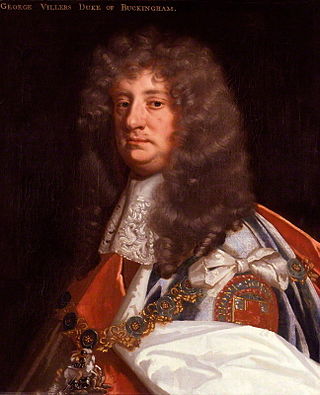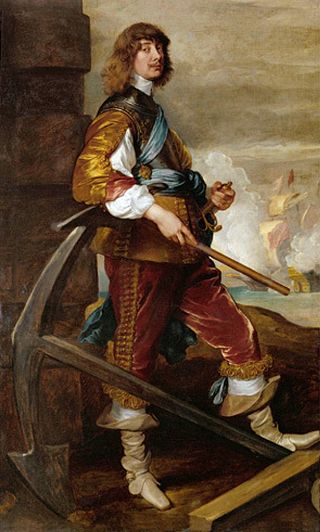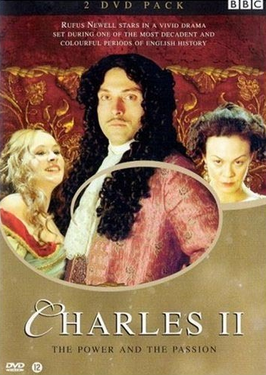
Charles II was King of Scotland from 1649 until 1651 and King of England, Scotland, and Ireland from the 1660 Restoration of the monarchy until his death in 1685.

The Restoration of the Stuart monarchy in the kingdoms of England, Scotland, and Ireland took place in 1660 when King Charles II returned from exile in continental Europe. The preceding period of the Protectorate and the civil wars came to be known as the Interregnum (1649–1660).

Henry Rich, 1st Earl of Holland, was an English courtier and politician executed by Parliament after being captured fighting for the Royalists during the Second English Civil War. Younger brother of Robert Rich, 2nd Earl of Warwick, a Puritan activist and commander of the Parliamentarian navy during the Wars of the Three Kingdoms, Henry was better known as an "extravagant, decorative, quarrelsome and highly successful courtier".

George Monck, 1st Duke of Albemarle KG PC JP was an English soldier, who fought on both sides during the Wars of the Three Kingdoms. A prominent military figure under the Commonwealth, his support was crucial to the Restoration of Charles II in 1660, who rewarded him with the title Duke of Albemarle and other senior positions.

George Villiers, 2nd Duke of Buckingham, 20th Baron de Ros, was an English statesman and poet who exerted considerable political power during the reign of Charles II of England.

John Maitland, 1st Duke and 2nd Earl of Lauderdale, 3rd Lord Maitland of Thirlestane KG PC, was a Scottish politician and leader within the Cabal Ministry.
The Declaration of Breda was a proclamation by Charles II of England in which he promised a general pardon for crimes committed during the English Civil War and the Interregnum for all those who recognised Charles as the lawful king; the retention by the current owners of property purchased during the same period; religious toleration; and the payment of arrears to members of the army, and that the army would be recommissioned into service under the crown. Further, regarding the two latter points, the parliament was given the authority to judge property disputes and responsibility for the payment of the army. The first three pledges were all subject to amendment by acts of Parliament.

Edward Hyde, 1st Earl of Clarendon, was an English statesman, lawyer, diplomat and historian who served as chief advisor to Charles I during the First English Civil War, and Lord Chancellor to Charles II from 1660 to 1667.

Edward Hyde, 3rd Earl of Clarendon, styled Viscount Cornbury between 1674 and 1709, was an English aristocrat and politician. Better known by his noble title Lord Cornbury, he was propelled into the forefront of English politics when he and part of his army defected from the Catholic King James II to support the newly arrived Protestant contender, William III of Orange. These actions were part of the beginning of the Glorious Revolution of 1688. Cornbury's choice to support his cousin Anne instead of William after the rebellion cost him his military commission. However, Cornbury's support of King William's reign eventually earned him the governorship of the provinces of New York and New Jersey; he served between 1701 and 1708.

The House of Stuart, originally spelled Stewart, was a royal house of Scotland, England, Ireland and later Great Britain. The family name comes from the office of High Steward of Scotland, which had been held by the family progenitor Walter fitz Alan. The name Stewart and variations had become established as a family name by the time of his grandson Walter Stewart. The first monarch of the Stewart line was Robert II, whose male-line descendants were kings and queens in Scotland from 1371, and of England, Ireland and Great Britain from 1603, until 1714. Mary, Queen of Scots, was brought up in France where she adopted the French spelling of the name Stuart.

Anthony Ashley Cooper, 1st Earl of Shaftesbury PC, FRS, was an English statesman and peer. He held senior political office under both the Commonwealth of England and Charles II, serving as Chancellor of the Exchequer from 1661 to 1672 and Lord Chancellor from 1672 to 1673. During the Exclusion Crisis, Shaftesbury headed the movement to bar the Catholic heir, James II, from the royal succession, which is often seen as the origin of the Whig party. He was also a patron of the political philosopher John Locke, with whom Shaftesbury collaborated with in writing the Fundamental Constitutions of Carolina in 1669.

George William Frederick Villiers, 4th Earl of Clarendon, was an English diplomat and statesman from the Villiers family.

Earl of Clarendon is a title that has been created twice in British history, in 1661 and 1776.

Algernon Percy, 10th Earl of Northumberland, 4th Baron Percy, KG, JP was an English aristocrat, and supporter of the Parliamentary cause in the First English Civil War.

Charles II: The Power and the Passion is a British television film in four episodes, broadcast on BBC One in 2003, and produced by the BBC in association with the A&E Network in the United States, which also released it in North America with heavy edits. It was produced by Kate Harwood, directed by Joe Wright and written by screenwriter Adrian Hodges, whose credits include David Copperfield and The Lost World.

Peregrine Bertie was an English politician, the second son of Montagu Bertie, 2nd Earl of Lindsey. A member of the court party, later the Tories, he sat for Stamford from 1665 to 1679, and from 1685 to 1687. Most active in Parliament during the 1670s, he and other members of his family were consistent political supporters of Bertie's brother-in-law, the Duke of Leeds throughout several reigns. While he never achieved significant political stature, he did hold several minor government offices: he was a captain in the Royal Regiment of Horse Guards until 1679, and a commissioner of the Alienation Office and a customs officer. The death of his wife's brother brought the couple an estate in Waldershare, Kent, where Bertie ultimately settled. He sat for Westbury after the Glorious Revolution, but showed little political activity compared to others of his family. Bertie stood down from Parliament in 1695 and died in 1701, leaving two daughters.

Sir Edward Villiers was an English Royalist soldier and courtier. Part of the powerful Villiers family, he was a friend of Edward Hyde, chief advisor to Charles I and Charles II from 1641 to 1668.
William Levett was the Oxford-educated personal chaplain to Edward Hyde, 1st Earl of Clarendon, whom he accompanied into exile in France, then became the rector of two parishes, and subsequently Principal of Magdalen Hall, Oxford and the Dean of Bristol.
Oliver St John, 5th Baron St John of Bletso KB was an English politician who sat in the House of Commons from 1624 to 1629 and in the House of Lords from 1639. He died fighting in the Parliamentary army in the English Civil War.
The Ministry of the Chits was the government of the Kingdom of England from November 1679 to 1688. The administration was led by three young ministers, collectively known as the chits: Laurence Hyde, Sidney Godolphin and the Earl of Sunderland.















